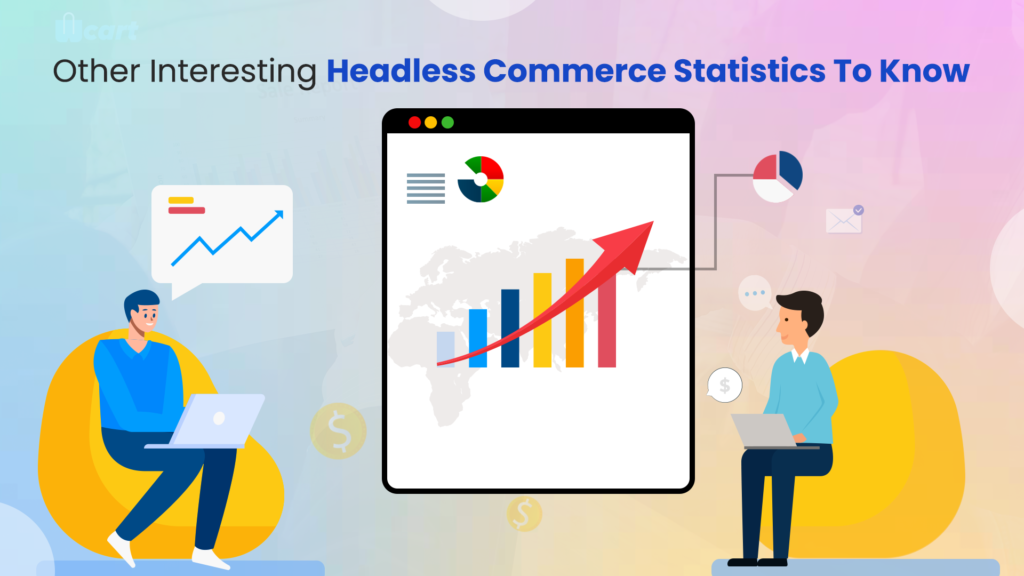Businesses are constantly seeking innovative ways to enhance the online shopping experience for their customers. Headless commerce has emerged as a powerful solution, offering flexibility and scalability to meet the modern digital marketplace demands. In 2022, 45% of global e-commerce businesses had already adopted headless commerce, and this number is projected to grow to 67% by the end of 2023. It’s important to explore the latest statistics and trends surrounding headless commerce to understand its impact and potential for businesses. From improved performance and customization to seamless omnichannel experiences, headless commerce is reshaping the way companies approach online retail.
Read More: Headless Commerce Explained
Headless Commerce Key Statistics And Trends

Funding for headless commerce platforms reached over $1.65 billion in 2020-2021 alone, indicating investor confidence in this potential technologies.
According to a commerce innovation report by commercetools, a significant 74% of organizations acknowledge that their failure to embrace emerging commerce solutions will have adverse effects on multiple aspects of their business.
More businesses adopt headless solutions, organizations expect the investment in implementing headless architecture to rise, with an average spending of $2.6 million.
80% of businesses that currently don’t have headless architecture plan to implement it within the next two years, as reported in the State of Commerce report by Salesforce.
77% of organizations with headless architecture state that it enables faster changes to their storefronts, allowing them to be more agile in responding to changing customer behavior and expectations.
Gartner research projects that organizations embracing a composable approach will achieve an 80% faster implementation speed for new features compared to their competition by 2023.
34% of organizations report found to make changes to their digital storefront, highlighting the need for agility
A significant majority of 76% of the individuals surveyed concur that headless commerce provides enhanced flexibility and customization options for digital experiences.
72% of respondents believe that headless commerce increases agility and enables faster changes.
57% of commerce leaders plan to implement headless commerce within the next two years.
69% of respondents acknowledge that headless commerce allows to add new sales channels such as social, voice, AR, and VR.
66% of respondents highlight improved integration between systems as a benefit of headless commerce.
Other Interesting Headless Commerce Statistics To Know

A survey of global business decision-makers found 68% takes their company three months or longer to bring new commerce solutions.
Half of the respondents reported that their organization’s technology limitations have hindered their ability to innovate quickly.
73% of respondents are likely to take their business elsewhere if a brand doesn’t provide the expected shopping experience.
36% of respondents feel jealous of competitors’ commerce offerings, particularly due to their competitors’ ability to introduce new offerings quickly.
According to 45% of respondents, organizations allocate only a minimal amount of annual budget to improving or expanding commerce capabilities.
By 2023, Gartner predicts B2C digital commerce platforms will experience a 30% price decline compared rates observed in 2019. We attribute this reduction to the commoditization of features and the implementation of “headless” architectures.
By 2024, approximately 15% of B2B organizations will utilize digital commerce platforms to facilitate and support all sales activities.
By the year 2024, industry projections estimate that approximately 10% of digital commerce enterprises will leverage pre-packaged business capabilities to construct their application experiences.
Industry projections anticipate that the adoption of composable application architectures will reduce the IT costs of managing SaaS operations by half by 2024.
Industry projections indicate that organizations that smoothly guide customers through their journeys by providing a unified commerce experience are expected to experience a minimum 20% increase in total revenue by the year 2025.
These statistics highlight the growing significance of headless commerce in the eCommerce industry.
Final Thoughts
In 2023, headless commerce is proving to be a ecommerce game-changer. With its ability to enhance performance, provide flexibility, and deliver seamless omnichannel experiences, businesses are embracing this innovative approach. Rising adoption of headless commerce solutions and the PWAs integration trends helps in shaping the future of online retail. For more queries and details, contact Wcart Expert team.
Frequently Asked Questions(FAQs)
What is the current adoption rate of headless commerce?
While specific figures for 2023 may vary, headless commerce has been steadily gaining adoption in recent years. According to 2022 industry reports, approximately 38% of retailers had already implemented and planned to implement headless commerce solutions. This trend will continue growing in 2023.
What are the primary industries embracing headless commerce?
Headless commerce is not limited to a specific industry and found relevance across several sectors. Ecommerce businesses, retail brands, hospitality, media, and entertainment companies have been at the forefront of adopting headless commerce to deliver smooth experiences across every channel and touchpoint.
Are there any notable trends in headless commerce for 2023?
In 2023, several trends are shaping. Some notable trends include the increased focus on PWAs, voice commerce integration, headless CMS adoption, AR and VR experiences, and the rise of headless commerce platforms offering more comprehensive features and integrations.
How does headless commerce impact customer experience?
Headless commerce empowers businesses to deliver highly personalized and consistent customer experiences across multiple channels. Businesses can iterate and optimize the customer interface independently by separating front-end and back-end. That resulted in faster loading times, improved user interfaces, and flawless user journeys, ultimately enhancing the overall customer experience.
Are there any challenges associated with implementing headless commerce?
Some common challenges include specialized development expertise, potential integration complexities, increased initial setup and maintenance costs, and the requirement for robust API management. However, with careful planning and using the right technology partners, these challenges can be reduced effectively.




Leave a Reply